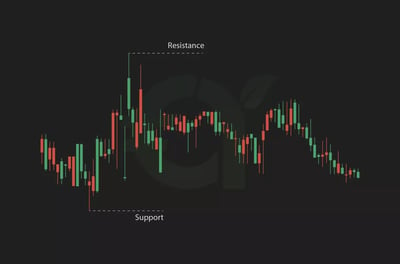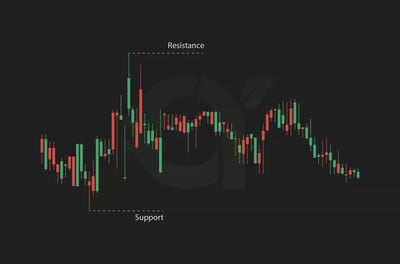Three Top Support and Resistance Trading Methods Explained
Support and resistance levels are important terms every new trader will need to master to make the most of their trading activities. More than simple terminology, support and resistance levels indicate important moments when the forces of supply and demand meet. Using technical analysis, traders can identify when the trends that underline price movements have reached their support (lower) and resistance (upper) levels.
These levels are not fixed points but rather zones where supply and demand dynamics influence price action. When a support level is broken, it can turn into a new resistance level, and when resistance is broken, it can become new support. Traders use support and resistance to set entry and exit points, manage risk, and confirm trading signals. We will explain more in this short article.
Day trading involves buying and selling financial assets within a single trading day to capture short‑term price movements
A small fraction of traders, around 3 percent, achieve profitability and fewer than 1 percent trade consistently with returns
True success often starts with part‑time effort while working another job
Day trading works best with clear strategies focused on risk management, time discipline, and identifying key support and resistance levels
Keeping a trading journal is vital for logging setups, trade rationale, outcomes, and emotional responses to build better patterns
Beginners should start with paper trading to test systems before investing real capital
Choosing the right broker is crucial for factors like execution speed, liquidity, reliability, and access to essential tools
Effective day trading requires ongoing practice, patience, emotional control, and continuous study to refine timing, execution, and resilience

What Are Support and Resistance Levels?
Every financial asset has an implied value, so it is no surprise to learn that these values oscillate depending on market forces like supply and demand, which are, in turn, driven by factors like sentiment and timing. The support level is a point at which an asset’s price is expected to stop falling after a downtrend for a period as a function of its plentiful supply.
After the price reaches a support level, meaning it has stopped falling, an increase in buyer demand normally pushes the asset value to rise. Resistance levels are reached when demand is in full swing, and the value of the item appreciates until it is concentrated at the upper end; then, traders start to sell. Over time, you can take an educated guess about the support and resistance levels of any asset through technical analysis. As you can imagine, it is mightily helpful when you can use this knowledge as the basis of a trading strategy. If used well and fed with quality information, support and resistance trading can be extremely powerful.
Traders normally identify support and resistance levels in a few ways. This information imparts important signals about when to enter or exit a market. It also helps to determine where to insert stops and limits. Traders normally visit historical price data as a surefire way to understand previous support and resistance levels. Studying patterns and charts is easy enough with the human eye if the market is slow-moving, like commodities, but with fast-moving markets, like FOREX, you will need the help of technical tools.
Another thing to keep within view is previous support and resistance levels. This simple method gives you a baseline to understand the behavior of the asset over time. As traders become more skilled, they often default to using technical indicators to isolate support and resistance levels, as these technology-enabled signals are faster to generate and more reliable.

Support and Resistance Levels in Action
Support and resistance trading is a basic method of trading. One of the most common trading strategies that deploys support and resistance levels is the act of going long (buying) when the price is approaching a support level or going short (selling) when the price is heading toward its resistance level.
Having reliable information about support and resistance levels gives you a much better feel for where you can place stops and limits below support and above resistance levels. This allows you to cut your losses at a pre-defined level, but it also allows you to sensibly accumulate profit with a well-timed take-profit order. It is a great way to exit a trade rapidly if the price breaches levels of support or resistance that disadvantage you. Here are three top support and resistance trading strategies:
1. Range Trading
Range trading happens in the predictable space between the support and resistance levels. After using their analysis to quantify these levels, traders try to buy at support levels (lowest) and sell at resistance levels (highest). Remember that support and resistance are not always perfectly predictable or straight lines. Some markets oscillate within a range and do not always touch the lowest support or the highest resistance levels. They may bounce up or pull back before you expect anticipate. Other markets might briefly break out beyond their established levels before returning within range.
2. Breakout Strategy (Pullback)
As we have said, sometimes a price will break out below support or above resistance. Traders try to take advantage of this by further increasing momentum in one direction. This could mean continuing to inflate demand in an asset going lower than its established support level. Traders do this in the hopes of causing enough momentum to start a new trend.
However, this runs the risk of falling for a false breakout, something many newbie traders do. More experienced traders are good at waiting for the pullback toward a certain support or resistance level before they enter a trade. Sometimes waiting for the market to respond before committing is the best way to go.
3. Trendline Strategy
The trendline strategy uses the trendline as either support or resistance. It is simple. All you need to do is draw a straight line connecting multiple price peaks or troughs. This gives you a trendline range within which to trade. It is not an exact science, but many traders find it an uncomplicated and relatively safe way to know when to enter and exit trades.
A valid trendline requires at least two significant price points, but the more touches it has, the stronger it is considered. Uptrend lines act as dynamic support, guiding prices higher, while downtrend lines serve as resistance, capping upward movements. Breakouts above or below a trendline can signal trend reversals or continuations, making them useful for setting stop losses and take-profit targets. Many traders combine trendlines with other indicators, such as moving averages or volume analysis, to confirm trade setups and reduce false signals.
Recommended Brokers
Using Moving Averages as Support and Resistance
Moving averages can function as dynamic support and resistance levels. This is a more technical method of establishing a trading range, enabled by Fibonacci numbers. To get a moving average, traders will include anywhere from 20- and 50-period moving averages (minute-by-minute or hourly) until they feel comfortable with the durability of their model. Some traders like to be overly careful and will look to analyze hundreds of moving averages over predefined time intervals before they feel comfortable.
Moving averages can track the market as a line of support or resistance. Traders can utilize these moving averages to make data-rich decisions about high-volume and fast-moving markets that are likely to continue trending and those susceptible to a breakout. If you are placing substantial trades, then it makes sense to look for the comfort of as much detail as possible, just don’t fall into analysis paralysis.
Conclusion
Support and resistance level consideration is one of the best ways traders can use data to trade the markets. It is an inclusive method because you can use simple calculations, such as drawing a trendline across prices peaks and troughs, or you can deploy the most sophisticated moving average analysis software on the market. The fundamentals are the same, and if you apply judicious methods of when to stop your losses or take profit, you can be very successful.






